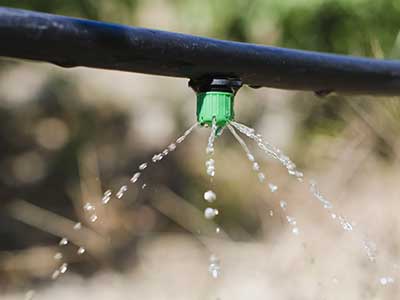
Agriculture is one of the major sources of livelihood for Indian farmers and contributes to the country’s GDP by 30% which is enormous this year. The CWC reported that the water utilization/withdrawal for irrigation accounted for nearly by 75%, followed by domestic use 10%, industries 5%, power development 5%, and other activities claimed about 10% including evapotranspiration losses, environment, and navigation needs. Around 80% of the water consumed by the irrigation sector is reduced to 60% due to the competing water demands from the other sectors. Irrigation efficiency varies from 55% to 90% depending upon the different methods adopted for irrigation, such as flood irrigation gives 65% water use efficiency; furrow irrigation gives 80% water use efficiency and micro-irrigation gives 85%–90% water use efficiency (sprinkler 85%, drip 90%). Initiatives shall be taken for improving the overall water use efficiency in the agricultural sector for surface water system and groundwater system from 30%-65% to 65%-80%.
 Accomplishing high water use efficiency is a major step towards sustainable water development and management. Precision irrigation is one of the ways forward towards achieving sustainable agricultural management. There are certain drawbacks that need to be addressed for consumptive water use in agriculture, such as reduction in water losses in the conveyance and distribution system through periodic maintenance, application of water to the roots of the plants directly using sprinkler, drip, and landscape irrigation methods, lack of awareness amongst farmers regarding new modern irrigation technology, inadequate networking amongst farmers, government, and the private sector providing precision irrigation techniques, absence of proper incentives and subsidies for modern irrigation technology, adaptation amongst farmers from various state governments, and the risk of crop failure amongst farmers by adopting new modern irrigation technology. Irrigation sector reformation requires improved water policy measures to develop synergy amongst the decisive water governance institutions, such as the Central Water Commission, State Irrigation Department, National Rainfed Area Authority, and Central Groundwater Board to ensure adequate water quantity availability for the poor and marginal farmers for agricultural use by reducing legal pluralism issues and water conflicts with respect to water equity based on gender equality. Best scientific practices should be adopted for improving the water use efficiency in the agricultural sector like proper management of cultural command area size based on crop water requirement, time linkage between water supplies for irrigation, and plant water requirement during khor period, crop selection based on climatic conditions and soil type, adequate provision to avoid excess water wastage on fields, minimize water evaporation losses from irrigated fields by using mulches, adaptation of precision irrigation techniques, such as furrow irrigation, pressurized irrigation (drip/sprinkler) under subsidy to farmers, use of hybrid seeds in drought-prone areas for drought-tolerance crops, 'more crop per drop' strategy should be adopted, participatory irrigation management promoted involving NGOs, local farmer's community, and the local government administrative body, consumptive use of surface and groundwater, economization of micro irrigation on large in India, etc. Espousing all the mentioned approaches, a goal of sustainable agricultural water management will be achieved, thereby augmenting the overall water use efficiency by around 75% to 80% in the agricultural sector.
Accomplishing high water use efficiency is a major step towards sustainable water development and management. Precision irrigation is one of the ways forward towards achieving sustainable agricultural management. There are certain drawbacks that need to be addressed for consumptive water use in agriculture, such as reduction in water losses in the conveyance and distribution system through periodic maintenance, application of water to the roots of the plants directly using sprinkler, drip, and landscape irrigation methods, lack of awareness amongst farmers regarding new modern irrigation technology, inadequate networking amongst farmers, government, and the private sector providing precision irrigation techniques, absence of proper incentives and subsidies for modern irrigation technology, adaptation amongst farmers from various state governments, and the risk of crop failure amongst farmers by adopting new modern irrigation technology. Irrigation sector reformation requires improved water policy measures to develop synergy amongst the decisive water governance institutions, such as the Central Water Commission, State Irrigation Department, National Rainfed Area Authority, and Central Groundwater Board to ensure adequate water quantity availability for the poor and marginal farmers for agricultural use by reducing legal pluralism issues and water conflicts with respect to water equity based on gender equality. Best scientific practices should be adopted for improving the water use efficiency in the agricultural sector like proper management of cultural command area size based on crop water requirement, time linkage between water supplies for irrigation, and plant water requirement during khor period, crop selection based on climatic conditions and soil type, adequate provision to avoid excess water wastage on fields, minimize water evaporation losses from irrigated fields by using mulches, adaptation of precision irrigation techniques, such as furrow irrigation, pressurized irrigation (drip/sprinkler) under subsidy to farmers, use of hybrid seeds in drought-prone areas for drought-tolerance crops, 'more crop per drop' strategy should be adopted, participatory irrigation management promoted involving NGOs, local farmer's community, and the local government administrative body, consumptive use of surface and groundwater, economization of micro irrigation on large in India, etc. Espousing all the mentioned approaches, a goal of sustainable agricultural water management will be achieved, thereby augmenting the overall water use efficiency by around 75% to 80% in the agricultural sector.

